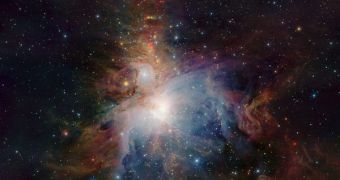Astronomers at the European Southern Observatory (ESO) have recently used their newest observatory, VISTA, to capture an amazing, new view of the Orion nebula, one of the most renowned structures in space. Because it was taken in infrared wavelengths, the new image was also able to penetrate the very thick layers of gas and dust that regularly enveloped the heart of this area of intense stellar formation. Therefore, astronomers can now peer deep inside, and make out the intricate mechanisms that promote the formation of new stars.
The Visible and Infrared Survey Telescope for Astronomy (VISTA) has a huge field of view, and is the latest addition to be made to the “arsenal” ESO already has installed at its Paranal Observatory. The 4.1-meter telescope has a remarkable mirror, and is widely considered to be the largest survey observatory in the world. Its unique capabilities were demonstrated yet again in the new image, which shocks through the clarity of details it provides. VISTA also incorporates a number of very sensitive detectors, all of which function in infrared wavelengths.
The new photograph shows the central, bat-like shape of Orion's inner region, where four very bright stars lie. These celestial objects form a structure known as the Trapezium. The stars emit massive amounts of ultraviolet radiation that clear the space around them, and make the gas in the surroundings glow. But, unlike visible light or ultraviolet surveys, infrared ones can reveal significantly more details of Orion. And the VISTA image also includes a wonderful panorama of the areas surrounding the stellar nursery itself. Orion is located some 1,350 light-years away from Earth.
“Looking to the region above the center of the picture, curious red features appear that are completely invisible except in the infrared. Many of these are very young stars that are still growing and are seen through the dusty clouds from which they form. These youthful stars eject streams of gas with typical speeds of 700 000 km/hour and many of the red features highlight the places where these gas streams collide with the surrounding gas, causing emission from excited molecules and atoms in the gas,” experts at ESO say on their official website.

 14 DAY TRIAL //
14 DAY TRIAL //